RE:VISIONISM
„European history to a considerable degree, attempts to control consciousness by the way it is presented.
We saw a movie called „The Birth of a Nation“. Why not the „Death of a Nation“?
Indigenous American nations existed at the time. At the the same time we speak of the „birth“ of some nations,
other nations were dying. History as propaganda, history as mythology,
creates and brings into consciousness. History by Europeans is seen as validation of truth.
It establishes authority. It’s a puzzling situation (…) that we use as arbiters of truth those who have lied to us most.“
Amos Wilson, The Falsification of Afrikan Consciousness: Eurocentric History, Psychiatry
and the Politics of White Supremacy (1993)
re:visionism
Die Gruppenausstellung “re:visionism” befasst sich mit diesen und weiteren Fragestellungen und nähert sich so interdisziplinär und spartenübergreifend dem Geschichtsrevisionismus insbesondere in der Kunstszene.
Kann man Kunst und Künstler:in voneinander trennen? Warum werden weiterhin Kunstschaffende gefeiert, die mehr als nur fragwürdige politische Ansichten hatten und haben? Wieso wird fast ausschließlich der eurozentristische Blick auf Geschichte und Kunstgeschichte als Standard genommen?
Die Veranstaltung ermöglicht eine kritische Debatte um Künstler:innen, die in diesem System von Geschichtsrevisionismus profitiert haben, und deren Leben und Werk (beispielsweise trotz eindeutiger NS-Vergangenheit) auch heute noch weitestgehend unkritisch kommentiert, oder gar glorifiziert wird.
Dem werden Werke unterschiedlicher Künstler:innen entgegen gestellt, die genau diesem System den Spiegel vorhalten, aufzeigen, welche Themen vergessen und übersehen werden und eine neue Sichtweise anbieten.
A critical analysis of historical revisionism in the art and cultural scene
Is it possible to distinguish between art and the artist? Why do we keep celebrating artists that have more than questionable political views? Why is the euro-centristic view the only one on history and art history?
The group exhibition “re:visionism” addresses these and other questions and approaches historical revisionism in the art scene from an interdisciplinary and boundary transcending point of view.
The event offers a critical debate about artists who profited off of historical revisionism and whose work and lives are still trivialized and glorified.
To confront this system we present works of various artists who hold up a mirror to highlight missing topics and provide new perceptions.
KÜNSTLER:INNEN
Kelsey Arrington
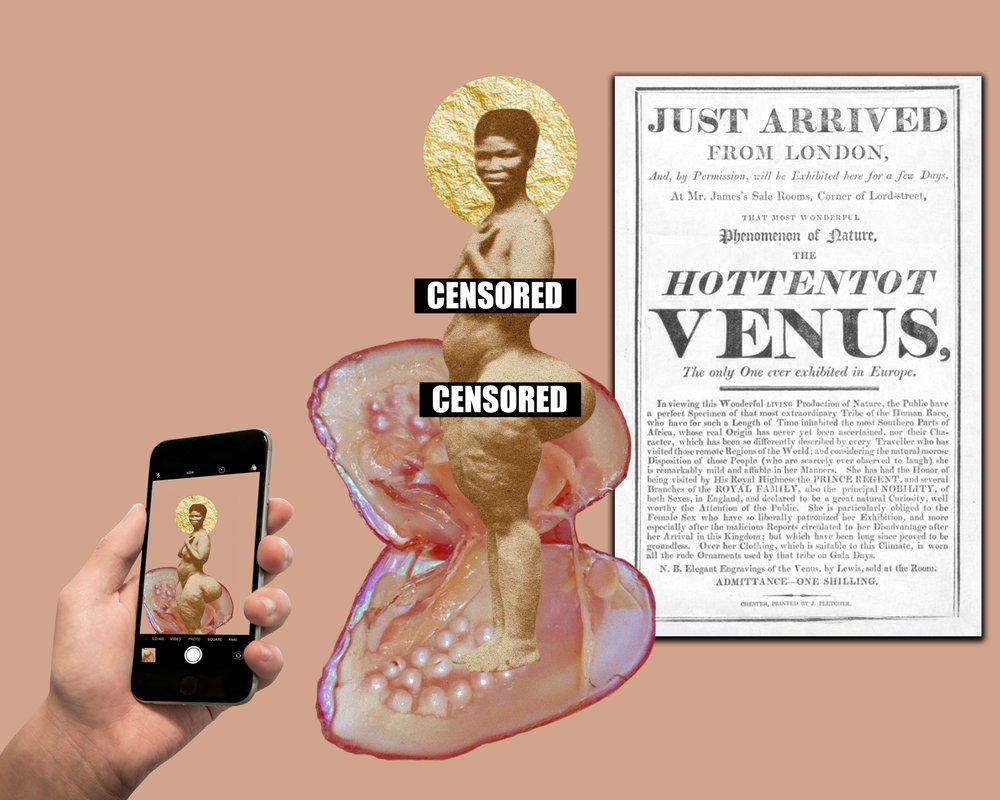
Kelsey Arrington „Death of Venus“
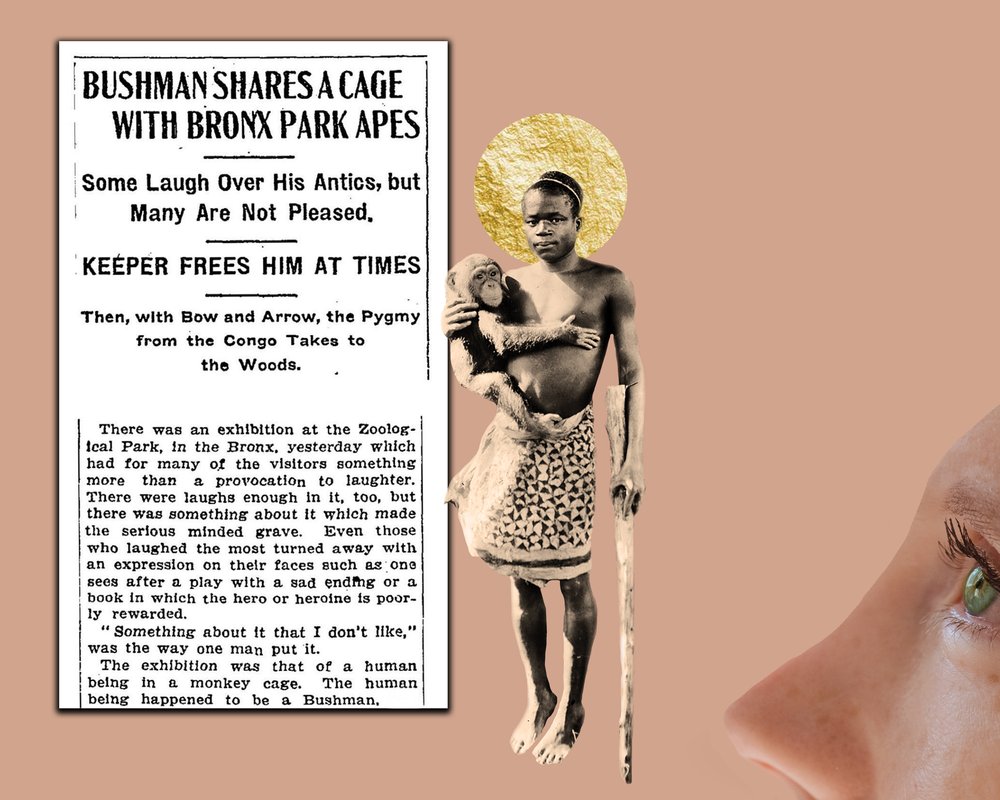
Kelsey Arrington “Man not Monkey”
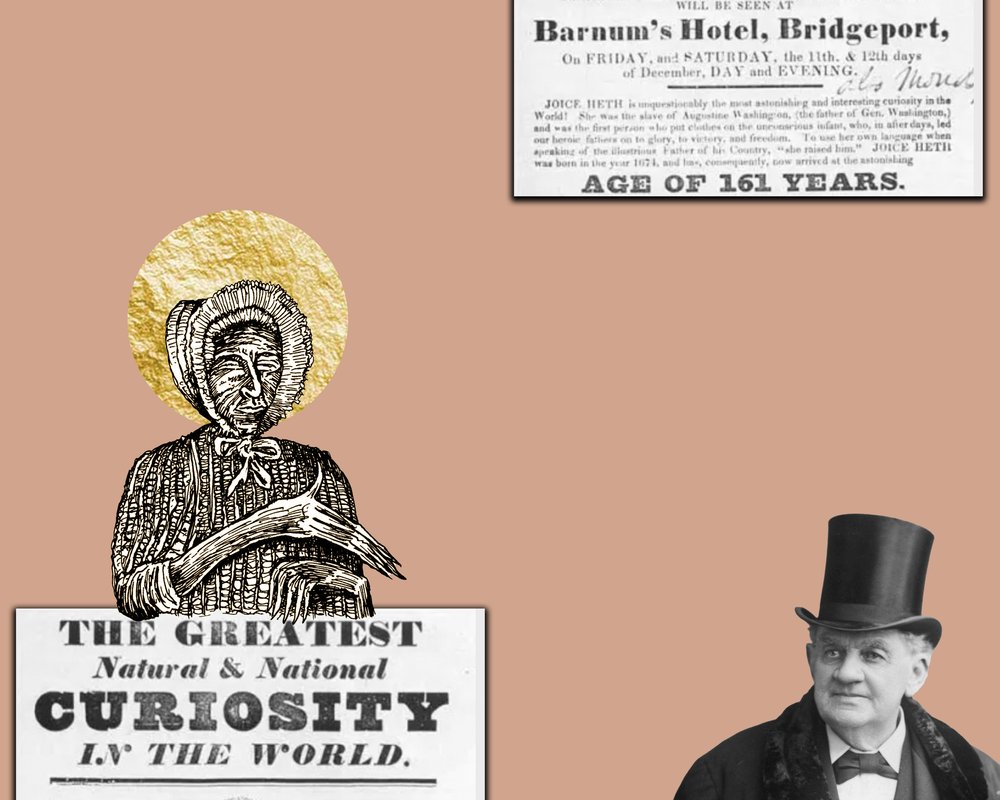
Kelsey Arrington “Not Your Mammy”
Kelsey Arrington (American, b. 1992) is an African American Fine Art Photographer. Born and raised in Detroit, MI, Arrington earned her BFA in Photography from the College for Creative Studies in 2015 before moving to Washington DC to work in the arts. She now travels nomadically, creating artwork informed by her exploration of the United States. Through her artwork, Arrington investigates the depths of identity in relation to American sociocultural anthropology. Working through a process of research and photographic manipulation, she aims to excavate personal truths regarding her own Blackness and womanhood in relation to American history.
„My art explores the nexus between identity and gender as a means to excavate personal truths. I am always trying to find myself in history, in the present and in the future; using photographs as a bridge between time and space. There’s an extremity to my interest in identity and how that impacts our world socioculturally. Through photographs I express the duality of my existence as a Black woman in America; a reality cursed by fetishization and dehumanization while simultaneously plagued with praise and pity. Black and a woman. In America, for so many, that is a death sentence. For me, it is a cavernous path but one I walk with pride. My new work, Pain Unveiled, addresses the dark history between the Western world and the African diaspora. In a series of photographic collages, I aim to pay homage to those whose pain was put on display.“
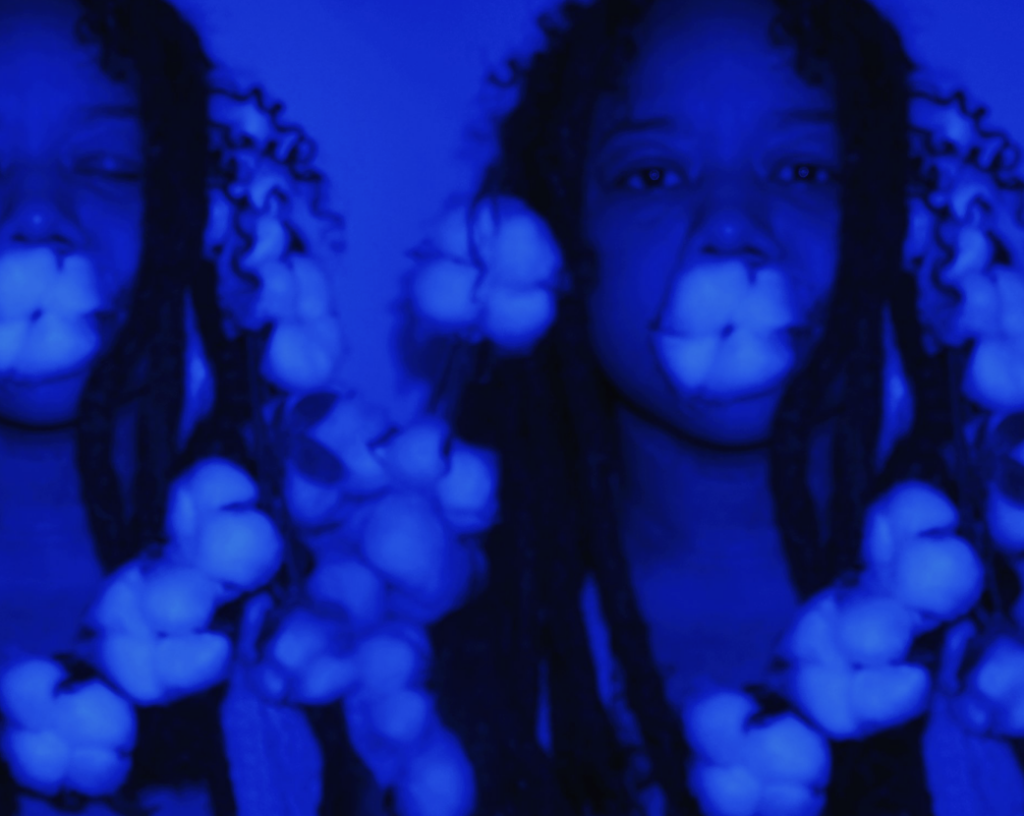
„In 1810, when Saartjie Baartman was in her early twenties, she was persuaded by an English ship’s doctor, William Dunlop, to travel to England to make her fortune. However, as a Khoikhoi woman she was considered an anthropological freak in England, and she found herself put on exhibition, displayed as a sexual curiosity. Dubbed The Hottentot Venus, her image swept through British popular culture. Abolitionists unsuccessfully fought a court battle to free her from her exhibitors.
Baartman was taken to Paris in 1814 and continued to be exhibited as a freak. She became the object of scientific and medical research that formed the bedrock of European ideas about black female sexuality. When she died in 1816, the Musee de l’Homme in Paris took a deathcast of her body, removed her skeleton and pickled her brain and genitals in jars. These were displayed in the museum until as late as 1985.
After five years of negotiating with the French authorities for the return of Saartjie Baartman’s remains, the South African government, together with the Griqua National Council which represents the country’s 200 000 Griqua people, part of the Koi-San group, brought Saartjie Baartman back to South Africa. On Friday 3 May 2002, in a moving ceremony attended by many representatives of the Khoikhoi people, Saartjie Baartman was welcomed back to Cape Town. Her final resting place is in the Eastern Cape, where she was born.“
Saartjie (Sarah) Baartman’s story, written by Saartjie Baartman Centre for Women & Children
In the late 1800s, colonial exhibits showcasing humans from colonized countries as well as pseudo-authentic villages became popular in the western world. So called „Human Zoos“ took place in the US as well as in several west European countries, and aimed to other, devalue, sexualize and stigmatize Black and Brown people. Numerous „performers“ died during these exhibits because of the terrible living conditions, especially due to not enough food as well as no warm clothes being provided to them.
One of them was Sussy Dakaro, an aboriginal young woman, who was trafficked by the manhunter Robert A. Cunningham to America and Europe, and died in 1885 aged 17 in Wuppertal after two years of racial abuse and violence while being exhibited as a „cannibal“ with eight other Aboriginal people.
One of the last colonial exhibits took place in Brussels back in 1958 during the World’s Fair. Especially one image of a Black toddler – „exhibited“ as part of a pseudo-Congolese village – being fed by a white woman, became popular and still reminds us of Europe’s role as a colonizer and its racist history.
What has been done to BIPoC back then, is being continued on a more subtle level today, whether it be Othering through Social Media Campaigns or devaluation in everyday life based on racial prejudices that are rooted in our colonial history.
written by Lisa Jureczko
Sources
Farah Nayeri, Remembering the Racist History of ‘Human Zoos’, in: The New York Times, 2021
Jana Turek, „Völkerschau“ im Zoo Wuppertal / Ein Gedenkstein für „Sussy Dakaro“, in: Deutschlandfunk, 2017
o. A., Das Schicksal eines Aborigine-Mädchens, in: WZ, 2017
o. A., Human Zoos: A Shocking History of Shame and Exploitation, in: CBC
Leonard Cruz
Leonard Cruz und Dana Lyn, Violinistin, Arrangeurin und Komponistin aus New York City, wurden ausgewählt, um gemeinsam für Joe’s Pub (The Public Theater in N.Y.C.) Digital Duets Micro-commissions zu arbeiten. Die Arbeit trägt den Titel Shapeshifting Game und beschäftigt sich mit asiatisch-amerikanischer Identität und Diskriminierung. ShapeShifting Game wurde während der COVID-19-Pandemie inspiriert, als es in den USA viel Missbrauch mit Hass und Verbrechen gegen asiatisch-amerikanische/pazifische Inselbewohner gab. Das Stück bringt auch ein Bewusstsein für die Entkolonialisierung, die die Philippinen beeinflusst hat, und wie Filipinos ihre indigene Abstammung und Kultur annehmen können. Shape-Shifting ist auch ein Teil des Animismus, bei dem sich Ureinwohner in verschiedene Tiere verwandeln können, insbesondere in Vögel, die die beiden Künstler erforschen wollten.
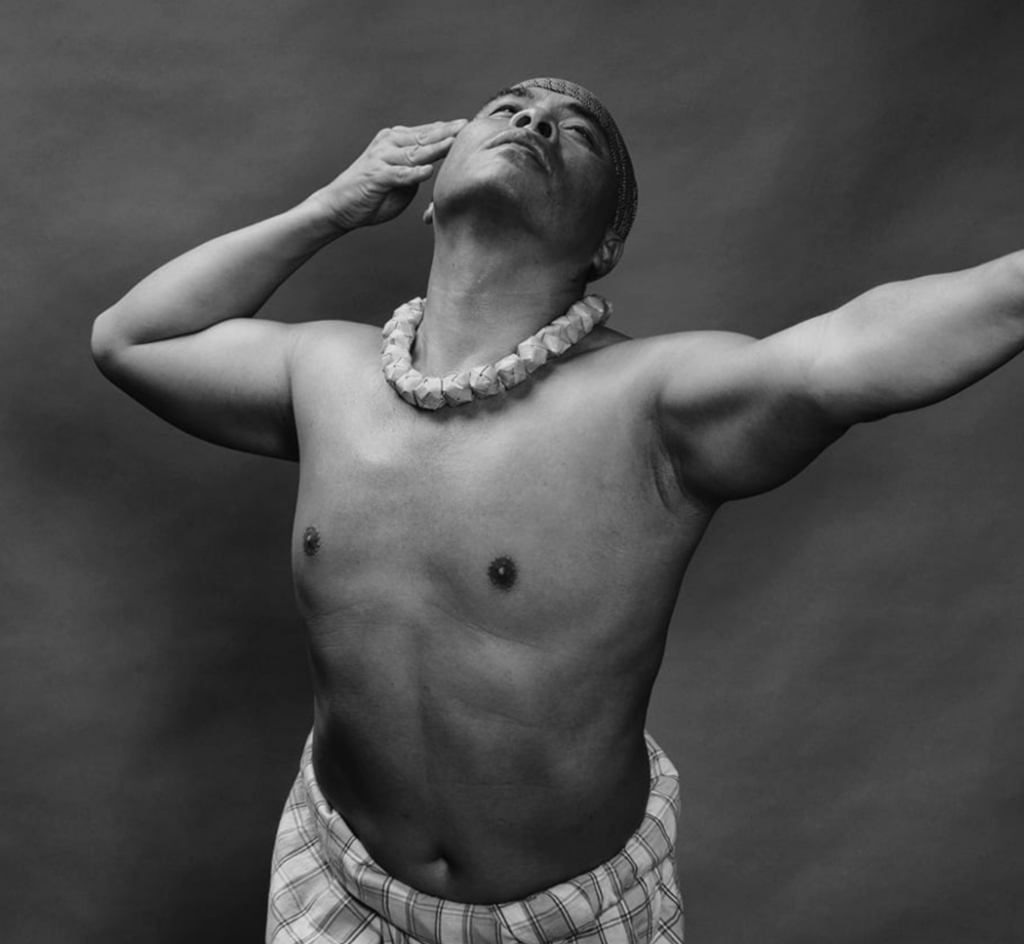
.
Leonard Cruz „Shapeshifting Game“
Dr. Leonard Cruz – Gründer des Creativity, Arts and Resilience Project (C.A.R.P.) – ist Performer, Choreograf, Lehrer, Berater für künstlerische Integration, Förderer kreativer Inklusivität und Verfechter einer kontemplativen Kultur. Er stellt sich eine Welt vor, in der Kreativität, Kunst und kontemplative Praktiken uns alle vereinen und niemanden ausschließen. Derzeit ist er Lehrbeauftragter an der HBK in Essen.
Die in Brooklyn lebende Musikerin Dana Lyn ist im New Yorker Lincoln Center, im Beacon Theatre, in der Brooklyn Academy of Music, in der Carnegie Hall und Town Hall sowie auf Folkfestivals und Dive Bars auf der ganzen Welt aufgetreten. Als Geigerin/Geigerin, Bratschistin, Pianistin und begeisterte Bassistin ist sie in den unterschiedlichsten Musikrichtungen zu Hause. Dana ist Absolventin der Joe’s Pub Working Group und wurde kürzlich mit einem 2020 NYFA Women’s Fund Award for Media, Music and Theatre und einem Sundance Composer Lab Fellow im Jahr 2021 ausgezeichnet.
„Discrimination against Asian immigrants began almost as soon as they entered the U.S. in the middle of the 19th century. The first immigrants were Chinese laborers looking for new work opportunities abroad in the aftermath of the Opium Wars. By the early 1850s, the 25,000 Chinese migrants attracted by the California Gold Rush constituted roughly 10% of California’s total population. Despite the integral role of these laborers in American mining, agriculture, textiles, and perhaps most prominently, the Transcontinental Railroad, Chinese immigrants faced mounting hostility from white settlers who saw them as an economic, health, and moral threat. Exclusionary immigration policies followed, and within 35 years, the Page Act of 1875 and the Chinese Exclusion Act of 1882 made legal Chinese immigration all but impossible. Chinese immigrants already in the U.S., who faced mass lynching, urban displacement, and violent attacks in their communities, had their options for recourse severely limited by People v. Hall in 1853, in which the California Supreme Court ruled that Chinese witnesses could not testify against white witnesses. Subsequent waves of Asian immigrants arrived in the U.S. seeking opportunities like Chinese immigrants before them — and they were met with similarly oppressive policies.“
„In the most recent decade, we have seen increasing anti-Chinese rhetoric from U.S. politicians on both sides of the aisle, echoed by media outlets, corresponding to China’s rise as a global superpower. This undercurrent of Sinophobia and racism accompanies the ongoing persecution of Chinese academics, scientists, and businesspeople, often on unfounded charges of spying, or solely due to their association with the Chinese Communist Party. And it undergirded the Trump administration’s racist descriptions of Covid-19 as the “China virus” or the “kung flu,” which has further fueled the anti-Asian racism, discrimination, and violence we’re witnessing in the U.S. today. As the complex racial politics of Asian Americans enter back into mainstream conversation, Asian Americans find themselves at a familiar crossroads.
History repeats itself — but we have the agency to choose how. We all must rally around the Chinese American and East Asian communities being targeted today and support communities under direct attack from racist violence. But there’s even more we can do. Violence in the U.S. during the Covid-19 pandemic, while directed nominally at Chinese people, has impacted Korean Americans, South Asians, Thai Americans, Filipino Americans, and even Latinx Americans. Building on the momentum, politicization, and racial awareness catalyzed by the ongoing Black Lives Matter movement, Asian Americans and their non-Asian allies can reject the model minority myth and recognize how anti-Asian racism connects every group under the Asian American umbrella.“
written by Lily Zheng
Lily Zheng, To Dismantle Anti-Asian Racism, We Must Understand Its Roots, in: Harvard Business Review, 2021
Paul Ayihawu
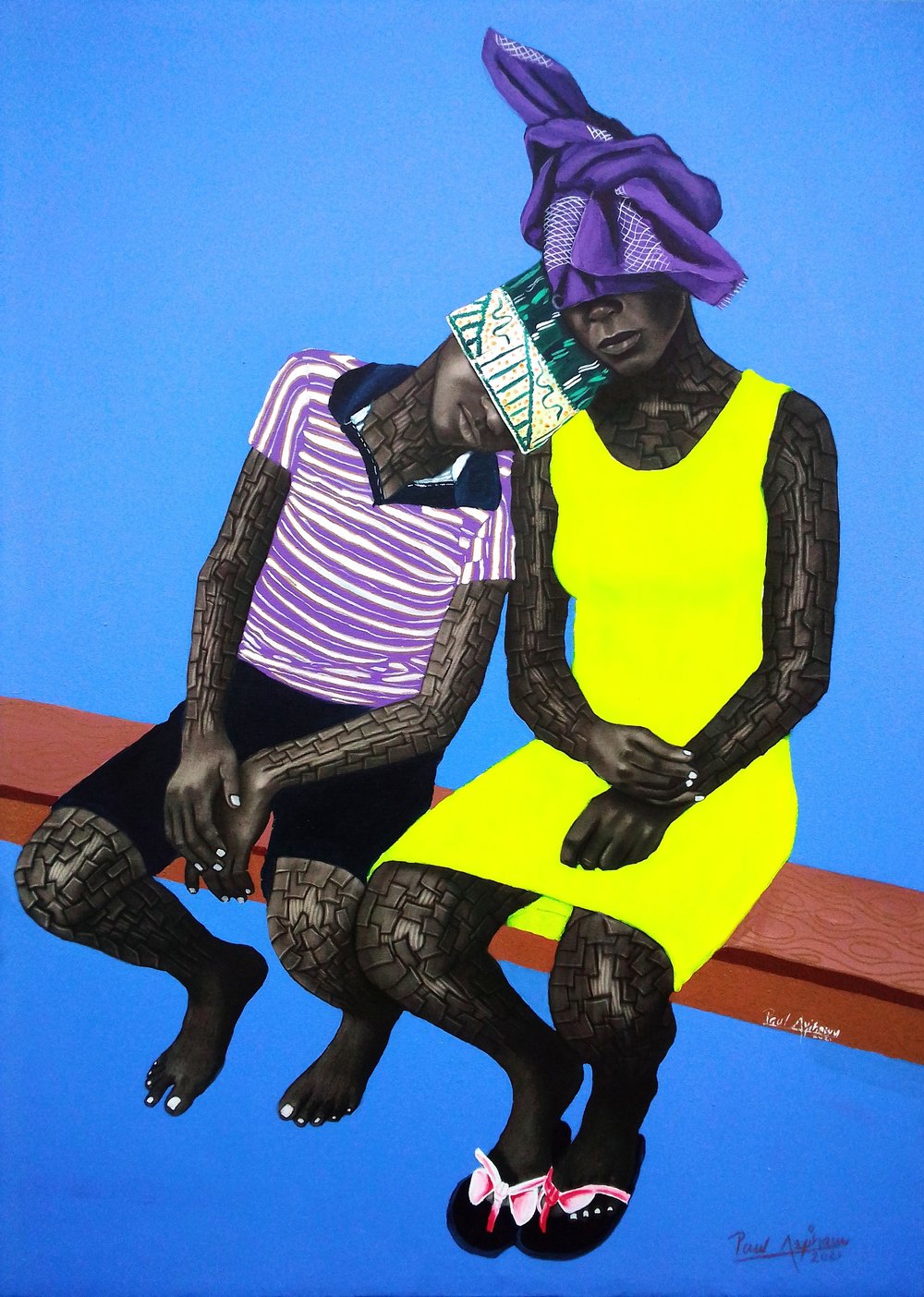
Paul Ayihawu „Day dreaming“
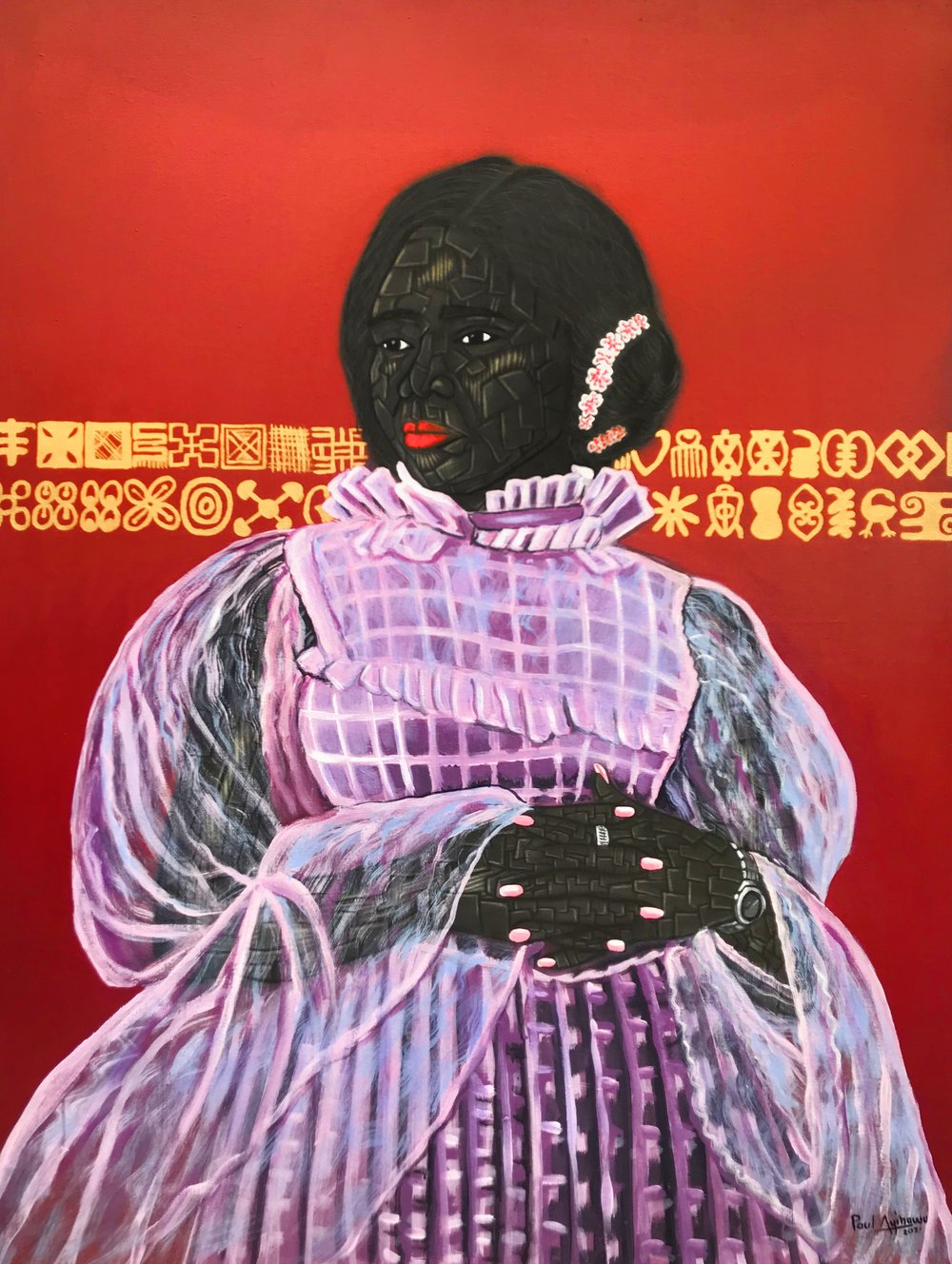
Paul Ayihawu „Black Lisa“

Paul Ayihawu „Lover Boy“
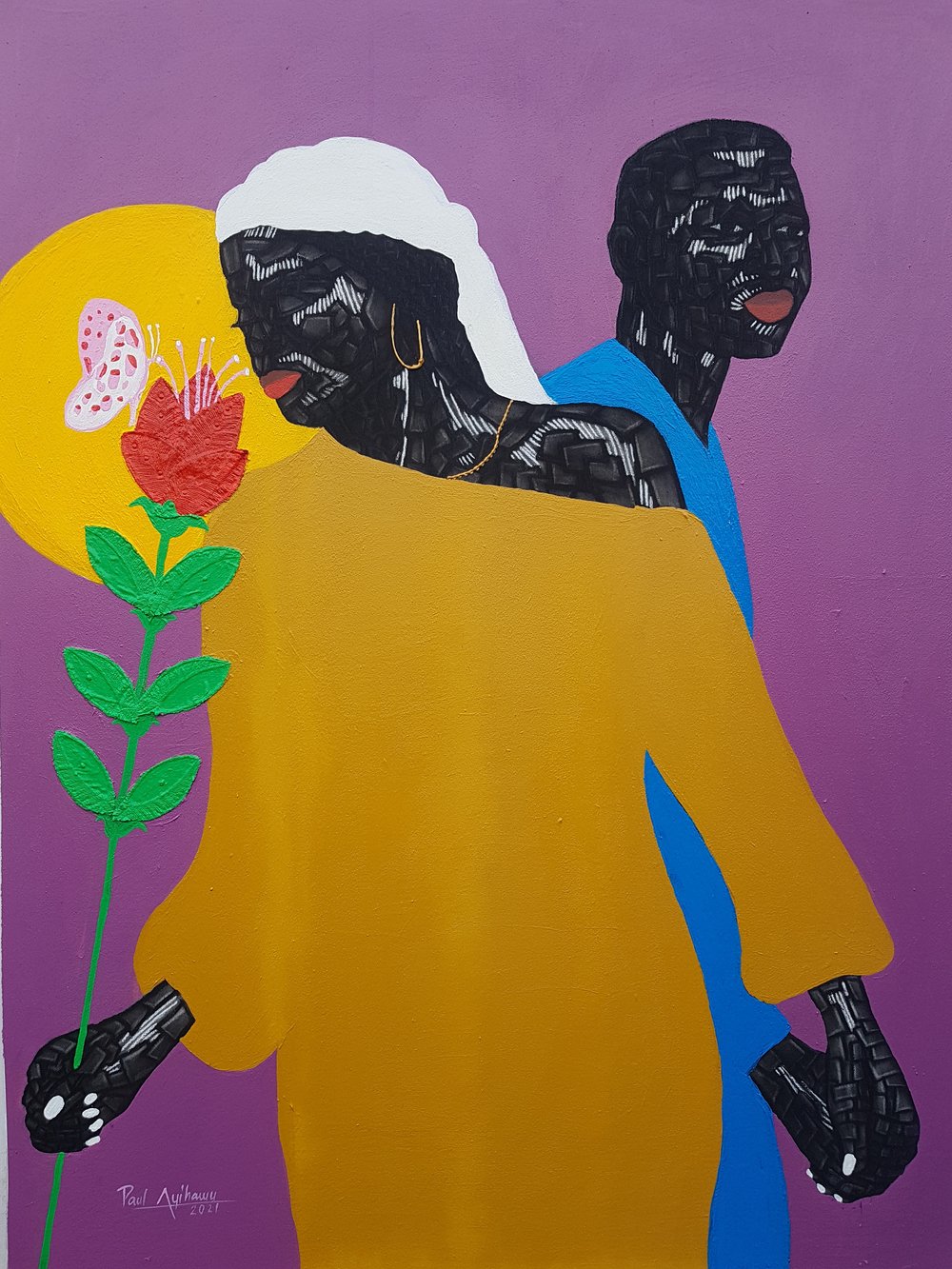
Paul Ayihawu „Stand By Me“
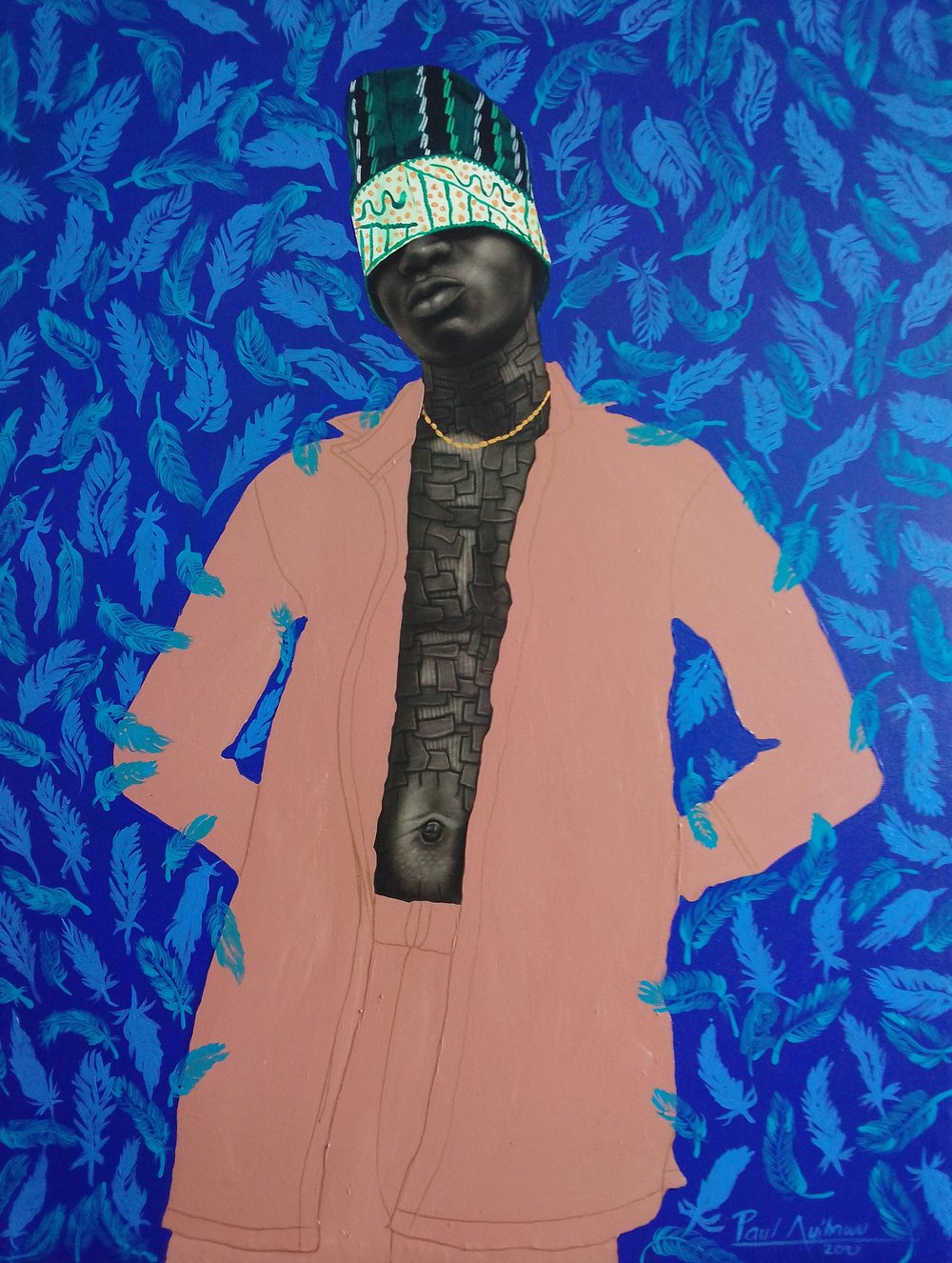
Paul Ayihawu „Untitled“
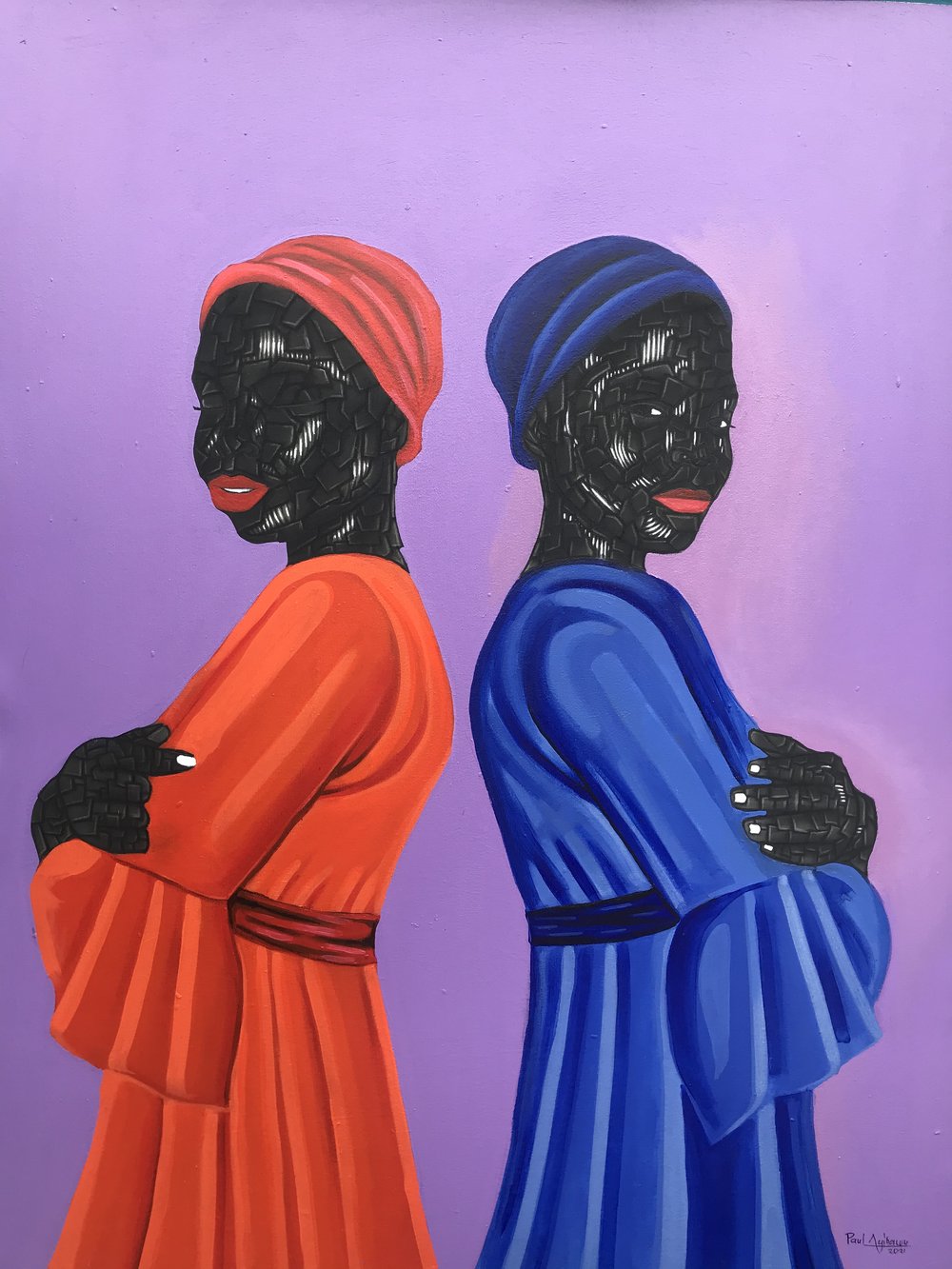
Paul Ayihawu „Soul Sisters“
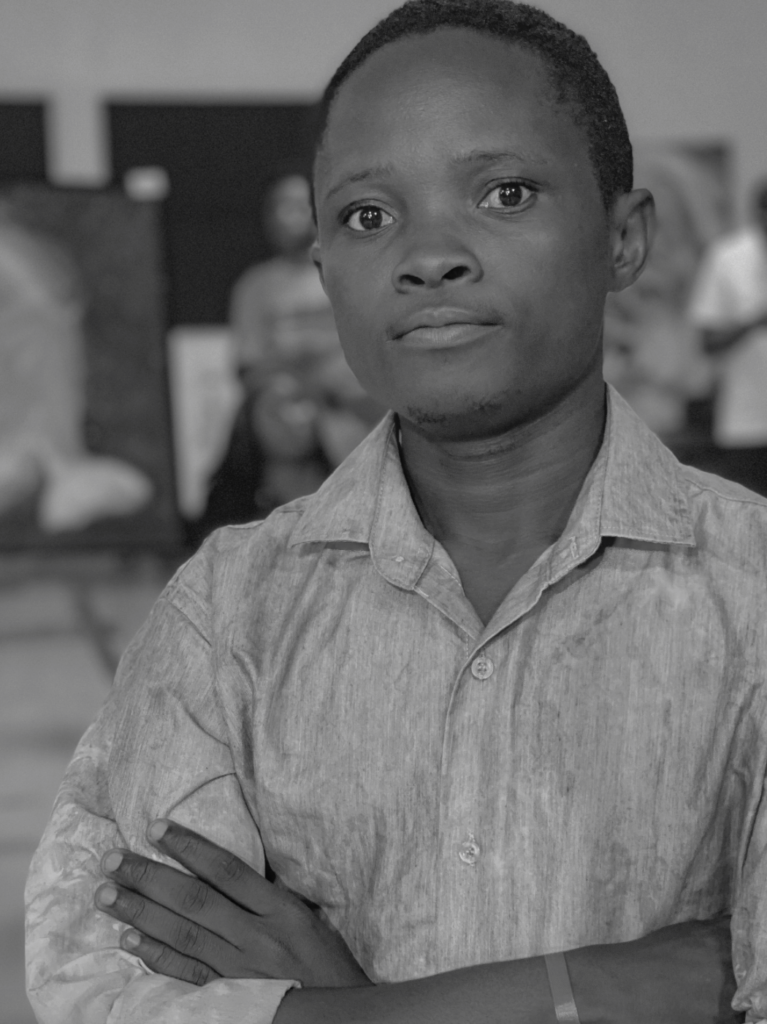
Paul Ayihawu is a Nigerian artist born in 1995. He is a self-taught artist who uses oil, acrylic and charcoal as his medium of expression. He is inspired by the works of Kerry James Marshall, Kehinde Wiley, and Njideka Crossby in his pursuit of painting the culture of black people in a new light. He uses his art to tell untold, unheard, and silent stories of Africans, with a focus on Nigeria. His work was selected for Joburg Fringe 2020 in South Africa, Ethan Cohen Gallery group exhibition 2020-2021 in London and exhibited in Lagos Fringe 2020 in Nigeria among others.
„Being a self-taught artist, my approach is to experiment with human forms and investigate the psychology of being, by capturing the emotional state of my subject at a particular moment and by asking: ‘how do we feel a sense of belonging in an environment that constantly tells us we are not enough?’ I work with mixed media using charcoal, oil, acrylic, and fabric to create a dialogue of human anatomy. I particularly love rendering the flesh tones in charcoal while all other parts are covered with vibrant colours. Sometimes I infuse signs and symbols of the rich West African heritage into my work to further illustrate my rich ancestry as a Nigerian/Beninoise.
My figurative pieces focus more on the socio-cultural impact of the African youth as I find meaning in the mundane activities and exuberance scene in the neighbourhood. I am also intrigued by the impact of colonialism on black culture and these are seen in the way I portray the figures in my painting which are characterized by poise, elegance, and iconic postures of the old masters’ paintings. I use my art as a form of activism to challenge the contemporary issues in the society.“
„The use of photography to represent European superiority in Sub-Saharan Africa was one of Empire’s most powerful weapons. Paired with the ‘legitimacy’ of the photograph, colonial powers were able to portray their apparent supremacy over peoples whom they believed to be uncivilized. The power of the photograph to depict purported truth reinforced the ideas of Empire and portrayed Africa as a place of savagery, death, and disease. This is a representation still common today. Yet it was not until colonial powers invaded Africa with missionaries and scientists that the continent grew ‘dark’ as it was flooded with ‘light’ (Ryan, 1997). This ‘light’ was often represented in photographs depicting white people standing in stark contrast to Africans, showing a difference in dress, stance, and power relations. They are all carrying specific racial messages. (…)
Race is created by one culture in order to justify its power over another. In this case, colonialists developed racism to justify power over African peoples. According to Lewis (1973), there are three ideological bases for racism: the separation between the culture of the colonist and the colonized; the exploitation of this difference to the betterment of the colonist; and the use of these theoretical differences as fact. Relying on these three criteria one can argue that photography was used as a tool to portray and ingrain these ideas into the master discourse of white superiority.
In addressing the first criteria colonial powers purposefully created images that contained blatant contrast between Africans and Europeans. This contrast played upon ‘light’ versus ‘dark,’ ‘civilized’ and ‘uncivilized’. There are vastly different cultures and peoples living in Sub-Saharan Africa and so it was a necessary step for colonialists to depict a homogenized Africa in order to create a separation between cultures. This step was crucial because it was the beginning of the still prevalent idea that Africa and its many nations are indistinguishable from each other. Through photographs and similar tools of representation, ideas of the ‘superior’ European were widely circulated and created through the trope of the ‘primitive’ African.
Perhaps the most powerful example of such representation is how these constructed ideas have become so embedded in western culture is a simple screen shot. A search done in Google Images portrays the exact stereotypes being researched in this paper, providing photographs of people dressed exclusively in traditional, ‘authentic’, and tribal attire. Above the original search bar other suggested searches include: poor, culture, starving, dancing, and AIDS. This search engine is structured to work with the perpetuation of mass media images and suggest the most commonly searched topics in regards to a subject. It is obvious then that those ideas about Africa constructed over a century ago are still present and prevalent in society today.“
Written by Hannah Mabry
Hannah Mabry, Photography, Colonialism and Racism, in: International Affairs Review, 2014
Qunyuan Wang
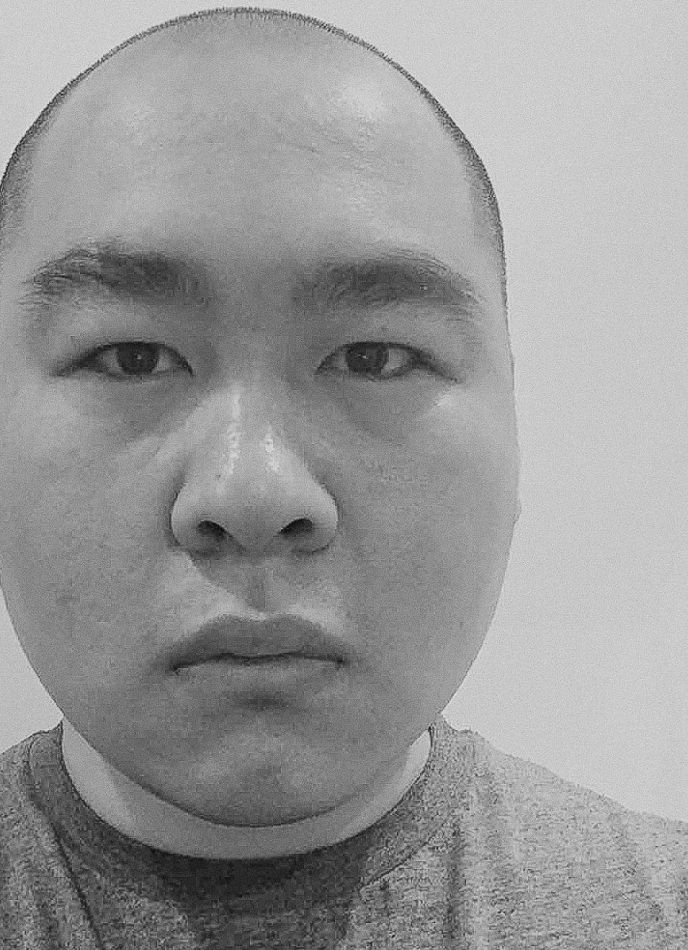
.
Contrapunctus I
„From street violence to war, why human beings are so keen on violence.“
Qunyuan Wang is an ultra-contemporary artist. Qunyuan Wang is a Chinese male artist born in 1989. Now studying at the Düsseldorf Art Academy by Prof.Marcel Odenbach. Lives and works in Düsseldorf. Qunyuan Wang is mostly exhibited in Germany, but also had exhibitions in Brazil, Belarus, China, Canada, Cambodia, Estonia, Greece, Italy, Iran, India, Nigeria, Russia, Slovakia and the US.
„Police Violence and wars play a huge role when it comes to historical revisionism. Both are tools used for centuries to oppress and abuse. In 2010, the so-called War Diaries were made public by Wikileaks. Over 391,000 reports about the wars in Iraq and Afghanistan between 2004 and 2009 shed light on the wrongdoings of the US military and its consequences for journalists and locals. Furthermore, Wikileaks released the Guantánamo Files, documents that showcase the realities of detainees in “a dark space where law and rights do not apply, where persons can be detained without a trace at the convenience of the U.S. Department of Defense.” The files also display the psychological abuse taking place in Guantánamo through the hands of the US government: “Direct physical violence is prohibited, in writing, but a formal policy of terrorising detainees during interrogations, combined with a policy of destroying interrogation recordings, has led to abuse and impunity.” The files did also reveal, “that only a few dozen prisoners are genuinely accused of involvement in terrorism. (…) The rest were either innocent men and boys, seized by mistake, or Taliban foot soldiers, unconnected to terrorism. Moreover, many of these prisoners were actually sold to US forces.” Wikileaks described the happenings as “the anatomy of a colossal crime perpetrated by the US government on 779 prisoners who, for the most part, are not and never have been the terrorists the government would like us to believe they are.”
As the Kyle Rittenhouse trial has shown, white terrorists are less likely to get a fair punishment for their morderous actions that were filmed by bystanders. While Rittenhouse, who killed two innocent people during a BLM protest, is now a guest on numerous alt-right and conservative TV shows and podcasts, the verdict might be a death sentence for future anti-racist protesters: “giving rightwing vigilantes a legal precedent to take up arms against anyone they consider a threat (…) means it is now open hunting season on progressive protesters. (…) It takes courage to publicly protest in any situation, particularly when protesting state powers. Now protesters in the US will have to fear not only police brutality but an emboldened and violent far right, fired up by the Republican party and the broader rightwing media and protected by the local legal system.
But the belittling of police brutality and terrorism aren’t solely a thing happening in the US. In 2005 Oury Jalloh died in a detention cell in Dessau. “A 2019 medical report, commissioned by the family of Jalloh, indicated several bones were fractured before he died, suggesting he was tortured before his death. Doctors from a clinic at the Goethe University in Frankfurt examined radiological images of Jalloh’s body and conducted an autopsy. It was already known that Jalloh’s nasal bone was broken when his body burned, but the new medical report showed that he had a broken rib and fractures to his septum and the base of his skull. A court ruled this inadmissible as evidence.”
A lot of questions are still unanswered when it comes to the terrorist attack in Hanau back in 2020, when 9 people were killed during a racist attack, as well as how the police handled the situation. “Why didn’t the emergency phone line not work properly that night? If the police had been notified immediately after the first shots were fired, the gunman might have been stopped before he went on to the second location. Why was the killer allowed to legally possess weapons? Why had he not come to the attention of authorities even though he sent a confused letter full of conspiracy theories to the chief federal prosecutor months before the racist attack?” The investigations are still taking place, especially because the victims‘ families put authorities and politicians under pressure, and publicly demanded answers to their questions.
written by Lisa Jureczko
Sources
Cas Mudde, Kyle Rittenhouse has walked free. Now it’s open season on protesters, in: The Guardian, 2021
Elliot Douglas, Death of asylum-seeker Oury Jalloh: German investigators slam police, courts and politicians, in: DW, 2020
Lisa Hänel, Mass shooting in Hanau: Grief and rage persist one year on, in: DW, 2021
Detainee Policies, WikiLeaks, 2012
Gitmo Files, WikiLeaks Reveals Secret Files on All Guantánamo Prisoners
Agbaka Oryiman
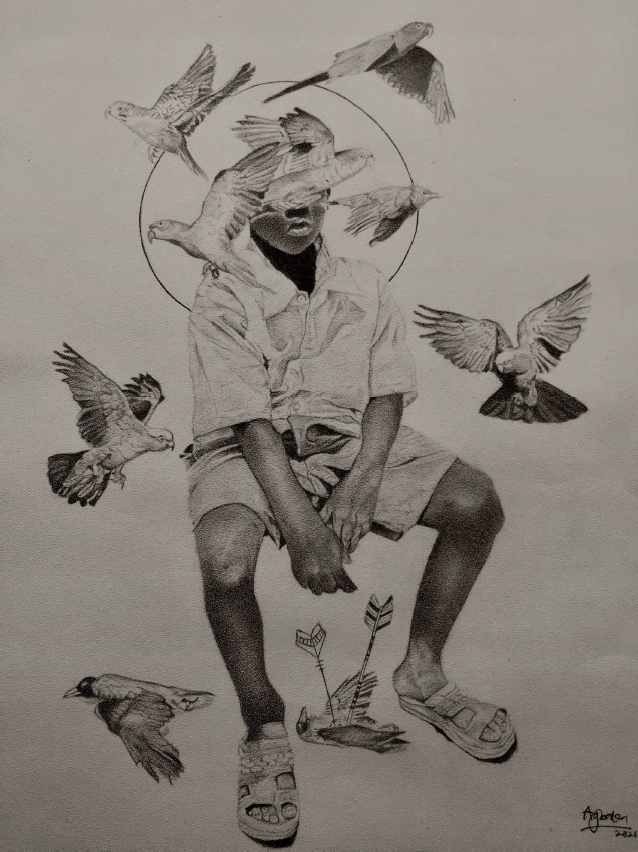
Agbaka Oryiman „Hunters: Angels and Demons“
This is an Original drawing done using ballpoint pen and ink on paper. Creating this piece was strongly influenced by the hardships and struggles that goes on in the ecosystem especially in Nigeria. In the present day modern times, the Society has grossly been ruled by capitalism and however been a constraint to the average communalist and also preventing love from thriving and in a long run tried to eliminate communalism from the contemporary African society. As the saying goes “we are all hunters and we must survive at all cost” And sometimes the predators becomes the prey.
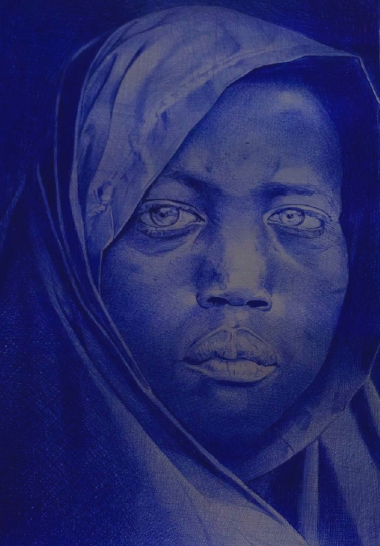
Agbaka Oryiman „Purpose“
This art piece questions modern day humanity and what really our purpose is. Do you know what your purpose is? What has been your impact after all these years. Who are we truly? I urge the viewers of this piece to have a deep reflection about these words.
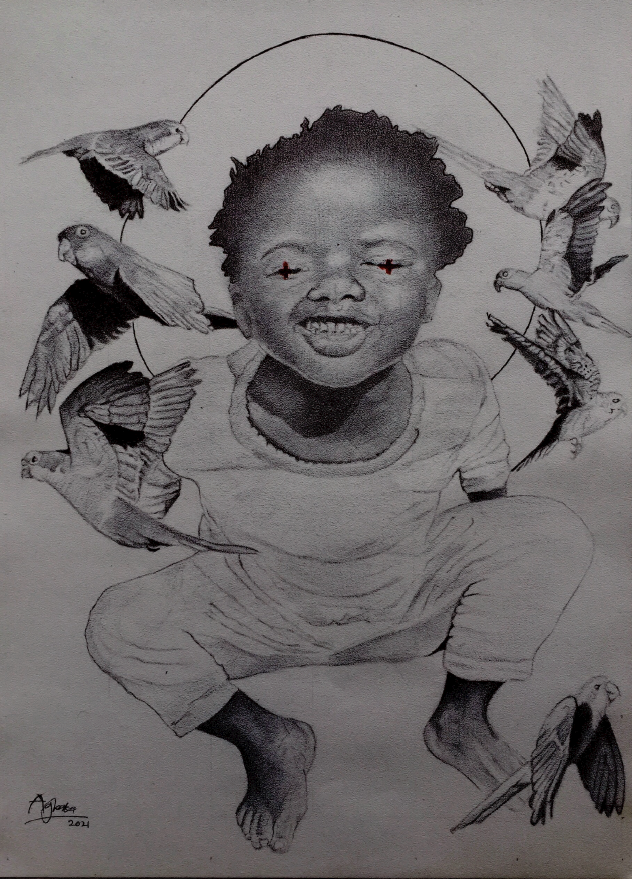
Agbaka Oryiman „freedom is a bird born of the Sun“
This is an original hand drawing done using ballpoint pen and paper about the existence of the artist. With the sun as the ruling planet, amidst the time of creation for this piece, the artist goes through the real fight for freedom. Freedom from anxiety, depression, trauma. But with the reassurance of the sun and the universe, he knows he is only a bird born of the sun and was born to be free as a bird.

Agbaka Oryiman „Afro“
An Original hand drawing done using ballpoint pen and ink on canvassed needle point paper. This is an art piece I made for the struggles of young Africans during this contemporary time to keep the Afro hair. The Afro hair culture has been unconsciously eroded as a result of the happenings from both the pre and post colonial era and societal change that came with it. Keeping the Afro shows difference in our individual styles and character but society and the change that came after, unconsciously has succeeded one way or another to suppress the Afro culture. This is a series I’m still working on and this is the first available piece.
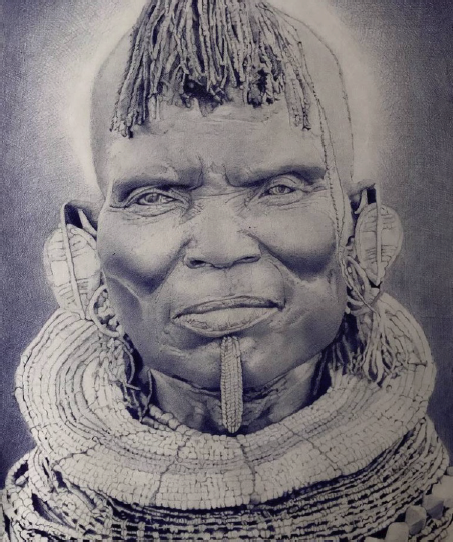
Agbaka Oryiman „Heritage“
An original hand drawing done using pen on paper. This masterpiece was born out of ten thousand mistakes while creating this piece, I started with a short meditation to sumone strength and add more patience in capturing little details to portray realism and tell the African history of Wealth and resources. This is a representation of an Elder in royalty in the precolonial African era dressed with heavy beads to portray high societal class of the elites before modern times guided by the sun.
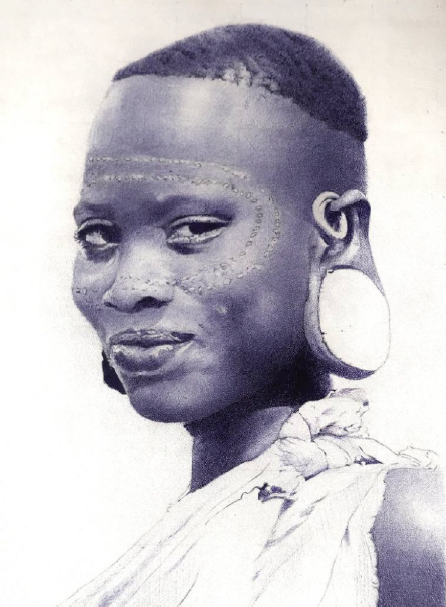
Agbaka Oryiman „Fati“
An original hand drawing done using ballpoint pen on needle point paper. Inspired by enam bosokah – about the importance of smiling to the next person and its ability to foster love and friendship and ease the pain away. My muse for this piece is a young and promising Fulani her name is Fatima.

Agbaka Oryiman is a self taught artist, painter, writer and story teller who loves to work in all mediums and styles of art, traditionally a Ballpoint pen artist who creates realistic portraits of his subject. He uses the ballpoint pen and ink because they are tools from ancient times used in telling stories and writings. He retells the stories and experiences of his subject by capturing their individual expressions, understanding the line language and understanding line movements while creating. He loves to educate young black Africans about the power that they posses by creating paintings about Africans and retelling their history. He also likes to dive into other aspects such as sculpting and street art painting. Agbaka loves making paintings on subjects from variety of topics like politics, music, culture, nature. Based in Nigeria currently in Benue State, living everyday by the dot.
„In order to understand the history of braids and Black American hair culture specifically, it is necessary to look at the impact of slavery on African women. Slavery brought not only physical and psychological trauma, but it also brought erasure. In an attempt to strip them of their humanity and culture, traffickers would shave the heads of women. Colonizers effectively attempted to take away the women’s lifeline to their homeland. Braids were also known to be used to hide rice or seeds in their hair in order to have food to eat on their Middle Passage journey. As women endured the hardships of slavery, there was no longer time to create intricate styles. Sunday, which offered somewhat of a relief from the harsh conditions, became the only day women could prep their hair. Since hairstyles needed to last the entire week, African-American women began to wear their hair in more simplistic styles. They chose to wear styles like single plaits that were easier to manage, and used the oils available to them, like kerosene, to condition them.
Remarkably, Black women used braids for another important use: a secret messaging system for slaves to communicate with one another. People used braids as a map to freedom. For example the number of plaits worn could indicate how many roads to walk or where to meet someone to help them escape bondage. Similarly in the early fifteenth century, hair functioned as a carrier of messages in most West African societies including the Wolof, Mende, Mandingo, and Yoruba. Hair was an important piece of a complex language system, in which it communicated the identity of the person wearing the braids.“
written by Lydia Kiros
Lydia Kiros, The Rich History of Braids, in: Amplify Africa, 2020
Laura Carvalho
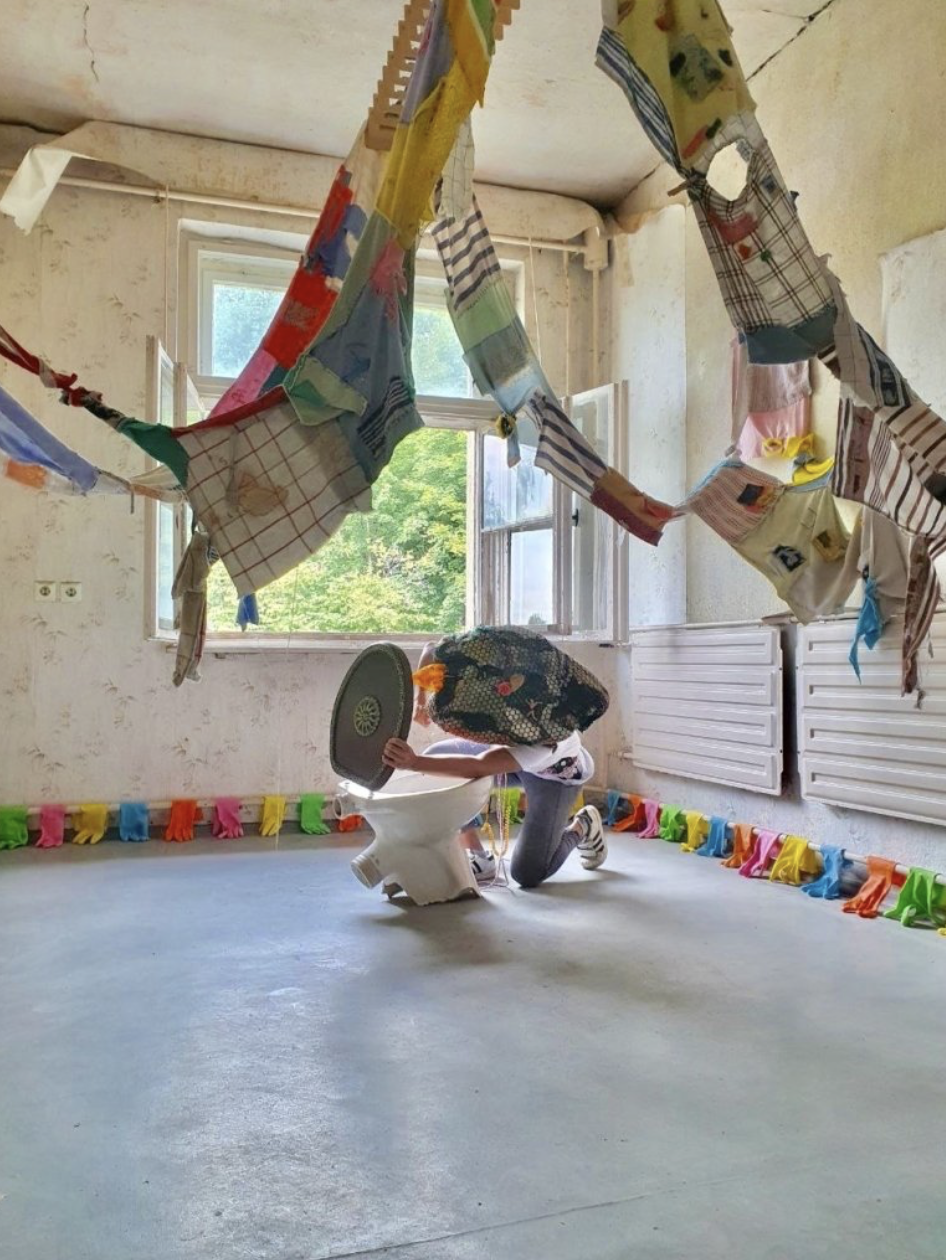
.
“Putzfrau/ Domestic Workers” (Performance)
LAURA_ AkiÓ-> PUTZfrau, is an installation/ stage performance, inspired by my experience as an immigrant domestic worker in Berlin and employer of a domestic worker, back in Brazil. Based in this ambiguous experience of being employer and employee, the artwork casts a discussion on domestic labour, the advent of virtual platforms mediating it and the consequences of coronavirus to vulnerable women working in such sector. The work draws a parallel between the artist profession, which is thought to be surrounded by glamour and status, and domestic work, which is still underpaid and poorly recognized.
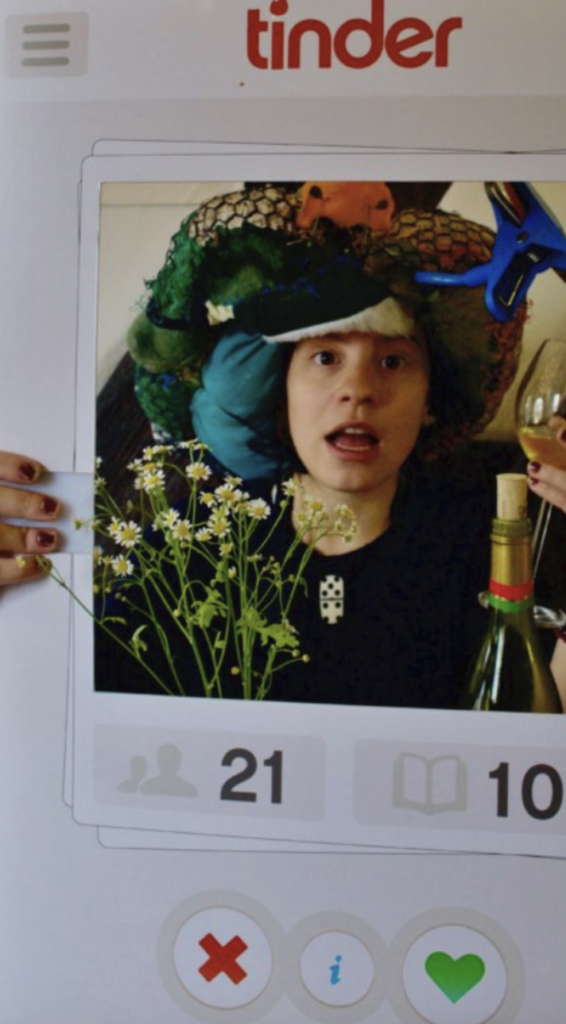
Laura Carvalho in her search for different ways of living/being has worked in programs of public health promotion with people suffering from mental illness and with people who are facing the abuse of psychoactive substances in the context of vulnerability. Was inside these apparently hostile environments, where Carvalho found a fruitful place for the development of her visual production. The dynamic ordinations, precarious and provisional, intrinsic in these environments are the substantial matter of her artwork. Just like the precision of the needle, her main instrument of work, which sews and redefines objects and fabrics, the artist aims the union of different areas of knowledge, techniques and methods, creating a symbolic weaving of new lines of thoughts.
„[Betty Friedan] did not discuss who would be called in to take care of the children and maintain the home if more women like herself were freed from their house labor and given equal access with white men to the professions. She did not speak of the needs of women without men, without children, without homes. She ignored the existence of all non-white women and poor white women. She did not tell the readers whether it was more fulfilling to be a maid, a babysitter, a factory worker, a clerk, or a prostitute than to be a leisure-class housewife.
Past feminist refusal to draw attention to and attack racial hierarchies suppressed the link between race and class. Yet class structure in American society has been shaped by the racial politic of white supremacy; it is only by analyzing racism and its function in capitalist society that a thorough understanding of class relationships can emerge. Class struggle is inextricably bound to the struggle to end racism. Urging women to explore the full implication of class in an early essay, „The Last Straw“, Rita Mae Brown explained:
„Class is much more than Marx’s definition of relationship to the means of production. Class involves your behaviour, your basic assumptions about life. Your experience (determined by your class) validates those assumptions, how you are taught to behave, what you expect from yourself and from others, your concept of a future, how you understand problems and solve them, how you think, feel, act.“ (…) White women who dominate feminist discourse, who for the part make and articulate feminist theory, have little to no understanding of white supremacy as a racial politic, of the psychological impact of class, of their political status within a racist, sexist, capitalist state.“
Bell Hooks, Black Women, Shaping Feminist Theory in: Feminist Theory from margin to center, 1984
LISA JURECZKO
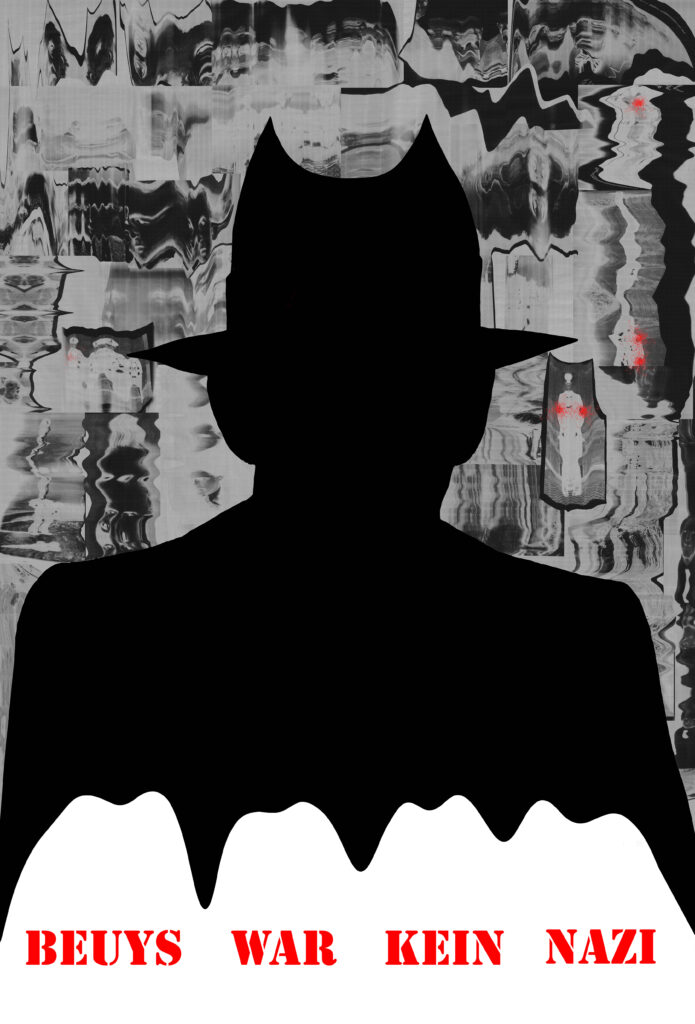
Lisa Jureczko “Beuys war kein Nazi”
On July 2nd, 1964 – 20 years after the attack on Hitler and on the day of remembrance for anti-fascist resistance fighters – the so-called Fluxus Performance of Joseph Beuys took place. A conflict arose between Beuys and one of his spectators which lead to a brawl between both of them. Beuys ended up with a bleeding nose, pulled out a crucifix out of his suitcase, then holding it like a chalice, and raising his right arm in a manner that resembled the Hitler salute. Just another performance and gesture that was both trivialized and smeared by the press afterwards.
Beuys, who joined the army voluntarily, was temporarily deployed in Poznan between May and December 1941. Beuys always claimed that he heard about violence and r*pe, but that these atrocities did not take place where he was deployed. According to Riegel, it is impossible that Beuys never witnessed the violence of German occupying troops, that he never neither saw a single forced laborer nor none of the local concentration camps inmates, especially because it is documented that the SS regularly killed jewish citizens in gas vans or cavities with caustic lime. Up to 15,000 people were murdered in the concentration camp of Poznan, which was located at a distance of approximately 1 km from Beuys military station. When applying for the professorship at the Art Academy in Düsseldorf, Beuys claimed that he had received several military badges, for example the Iron Cross. Riegel assumes, that Beuys had probably found them on the streets at the end of the war when it became common for officers to throw those badges away in fear of consequences or sanctions by the enemy troops. Also: receiving the Iron Cross by authorities always implied killing numerous soldiers of the enemies‘ troops. Does this mean, Beuys was actually a murderer?
Beuys, who participated on several meetings with his former comrades-in-arms until the 1970s, was surrounded by very few women and quite a lot of old white men with a Nazi history. The following is an incomplete list of Beuys‘ Nazi friends or Nazi’s he admired:
- Dr. Wilhelm Schiefer, member of the National Socialist party, author of books with openly antisemitic contents and principal of Beuys‘ former school. When directly asked in 1982, Beuys denied that those contents were taught in his school.
- Hanns Schwarz, head of the Hitler Youth orchestra and Beuys‘ former music teacher, who was teaching his pupils in his Storm Troopers (SA) uniform. Although he was known for being a “fanatic National Socialist”, Beuys admired him for being a “very attractive teacher”.
- Konrad Lorenz, a zoologist whose Nazi career has been made public in the 1970s and whose racist theories were based on ideas such as the need of a biological selection or differences between human “races”. Throughout his life, Beuys claimed to have known Lorenz although there’s no evidence that they’ve actually ever met each other.
- Walther Brüx, founder of the artist association “Niederrheinischen Künstlerbundes Kleve” to which Beuys belonged, too. Brüx was a former student of Bernhard Bleeker, a lecturer and sculptor who amongst other works created a then well-known Hitler bust. Bleeker was member of the National Socialist party from 1932 to 1945 as well as of organizations such as the National Socialist association for lecturers.
- Dr. Hildebrand Gurlitt, director of the Art association of Rhineland was known as Hitler’s art dealer who had been authorized by Goering to deal in so-called “degenerated art”. In 1954, Gurlitt’s secretary Marie Louise von Maltzahn assigned Beuys to produce furniture for Gurlitt.
- Hermann Wurmbach, father of Beuys‘ wife Eva, was member of the National Socialist party since 1933 as well as the SA. He was known as “fanatic and convinced Nazi” as well as “race theorist”. As a member and leader of the National Socialist association for lecturers he was co-responsible for jewish lecturers and dissidents loosing their jobs at the University of Bonn. Especially his “scientific” publications show how much of a convinced Nazi he was: in one of his scripts from 1940 he explains the alleged physical and mental differences between human races, and why he thinks the “nordic races” is superior to any other race. Furthermore, Wurmbach commented positively on the concepts of euthanasia and forced sterilization.
- Knut Hamsun, a Norwegian author who was also a passionate supporter of Hitler. On May, 7th 1945 he published an orbituary for Hitler. Because of this orbituary as well as his membership in the Norwegian National Socialist party Hamsun was arrested and convicted. In 1961, during the trial against Nazi functionary Adolf Eichmann, Beuys wrote down a note that says: “Immediate post-war era – most important man: Hamsun!”
- Karl Ströher, year-long funder of Beuys. Ströher was known being a “passionate supporter of Hitler” to whom he wrote numerous letters, and founded a local group that was controlled by the SA. Ströher also dispossessed his former jewish business partner between 1938 and 1940, and exploited forced laborers.
- Erich Marx, became Beuys‘ funder after Ströhers death in 1979. Marx became a member of the National Socialist party in 1939.
- Werner Georg Haverbeck, member of the National Socialist party since 1926 and former member of the SS, who later in life founded the so-called Collegium Humanum with his wife Ursula Wetzel-Haverbeck, which was banned a few years later due to its distribution of theories surrounding the Holocaust denial. In 1981 he signed a racist script of alt-right academics whose aim was to warn about the German nations “foreign infiltration” and its risks for the German people.
- August Haußleiter, a politician who was an active member in several rightwing and far-right organizations and parties. Beuys stood as a candidate for the AUD, a party founded by Haußleiter. The AUD was considered to be a far-right party and was monitored by the Office for the Protection of the Constitution.
- Georg Otto, active member in several rightwing organizations and parties
- Herbert Gruhl, later founder of the right-ecological ÖPD party
- Baldur Springmann, president of the ÖPD, later functionary of the AUD, and former Nazi as well as member of the SA and SS.
- Beuys met Haverbeck, Haußleiter, Otto, Gruhl, and Springmann in order to found a new party (Die Grünen) in 1977.
Karl Fastabend, Beuys‘ secretary, who wrote nearly all of Beuys political texts and in the 1970s, was a former Nazi, who joined the SA as well as the National Socialist party in 1932, and the SS in 1933. - Hermann Josef Abs, board spokesman of the German bank, whose capital grew due to the so-called Aryanization and who lead a company near Auschwitz where thousands of forced laborers died during the Nazi era. Abs belonged to Beuys close relatives.
- Wilhelm Schmundt, anthroposophist and brother of Rudolf Schmundt, one of the closest confidants of Hitler, who died during the attack on Hitler on July 20th 1944. Beuys and Schmundt were in contact since their first encounter in 1973.
- “wir selbst – Zeitschrift für nationale Identität”, a right-wing magazine that published a cover story filling seven pages with numerous photographs of Beuys and his portrait on its cover in 1982. Part of the article was Beuys‘ “Aufruf zur Alternative”. The Free International University, an association founded by Beuys, was named as author of the cover story.
How does a family cope with the own entanglement in Germany’s Nazi history, especially if one of your relatives is Heinrich Himmler, the person who prompted the Holocaust and is therefore responsible for the death of millions of jewish people?
In 2005, Katrin Himmler – granddaughter of Heinrich Himmler’s brother Ernst – published a book about her families history, shedding light on how historical revisionism influenced her own idea of her granddad’s role in Nazi Germany. While her family never denied Heinrich Himmler’s atrocities, they trivialized the complicity of other Himmler relatives. Both Gebhard and Ernst Himmler profited off of Heinrich’s status and contacts. Furthermore, private letters show that also their parents were passionate about the politics in Nazi Germany and their children’s careers.
What Katrin Himmler depicts in her book can be described as year-long revisionist gaslighting and stonewalling: when asked about her past relatives‘ opinion regarding National Socialism, her parents responded with vague statements or claimed that they “didn’t know” whether their relatives knew what was going on or that they were simply “too naive” to understand the devastating consequences of Hitler’s politics. Those who asked questions were also met with daylong accusatory silence or confronted with romanticizing stories about their Nazi ancestor’s benevolence towards other family members or neighbors. Especially their narrative of Ernst’s passivity didn’t fit to Katrin’s archive finds of him becoming a member of the National Socialist party in 1931 and of the SS in 1933.
At the same time, the historical revisionism in private seems to be a consequence of the Nazi propaganda throughout the war years: while the German army lost battle after battle, the press reported about victories that never had happened. The defeat came as a surprise for many, so denying the very own responsibility appeared to be an adequate coping mechanism for numerous former supporters and perpetrators of the German Nazi regime.
Katrin Himmler explains how the lies about Heinrich Himmler being an “individual case” or an “abnormality” in their family history and about them only rarely being in contact with the Nazi official served them to appear “normal” and therefore not complicit in the Nazi’s crimes. It saved them from the consequences they might have faced in the post-war era when the denazification began and those who were economically thriving in Nazi Germany had to find ways how to keep their positions of power with the new political rulers.
At the end of the day, people like Heinrich Himmler were not only dependent on the general population’s approval, they actually would have never been able to get their power without the masses‘ support, their belief in the German’s populations‘ superiority, their patriotism or their ignorance.
As Andrew Moxon (alias Julius Goat) wrote on Twitter a few years ago: “Historians have a word for Germans who joined the Nazi party, not because they hated Jews, but out of a hope for restored patriotism, or a sense of economic anxiety, or a hope to preserve their religious values, or dislike of their opponents, or raw political opportunism, or convenience, or ignorance, or greed. That word is “Nazi.” Nobody cares about their motives any more.“
written by Lisa Jureczko
Sources
Catrin Lorch, Die wirren rechten Ideen des Joseph Beuys, in: Süddeutsche Zeitung, 2018
Christiane Hoffmans, „Das ist völkische Diktion in Reinkultur“, in: WELT, 2013
Christiane Hoffmans, Das rechte, völkische Gedankengut des Joseph Beuys, in: WELT, 2018
Hans-Joachim Müller, Joseph Beuys, ein Fachverkäufer der hohlen Kunst, in: WELT, 2017
Hans Peter Riegel, Beuys: Die Biographie (Band 1 bis 4), 2021
Hans Peter Riegel, Interview: „Ich verdanke Beuys den unabdingbaren Willen, etwas zu bewirken.“, in: SWR2, 2021
Hans Peter Riegel, Interview: „Man muss Beuys den Heiligenschein nehmen.“, in: die presse, 2021
Hans Peter Riegel, Interview: „Beuys war bis ins Mark völkisch.“, in: Frankfurther Rundschau, 2013
Katrin Himmler, Die Brüder Himmler, Frankfurt am Main 2008
Thomas Kerstan, Lernen für den Führer, Ein Gespräch mit der Historikerin Anne C. Nagel, in: DIE ZEIT Nr.45/2012
Andreas Daams, Der Klever Bildhauer Walther Brüx, in: NRZ, 2016
avan amir weis
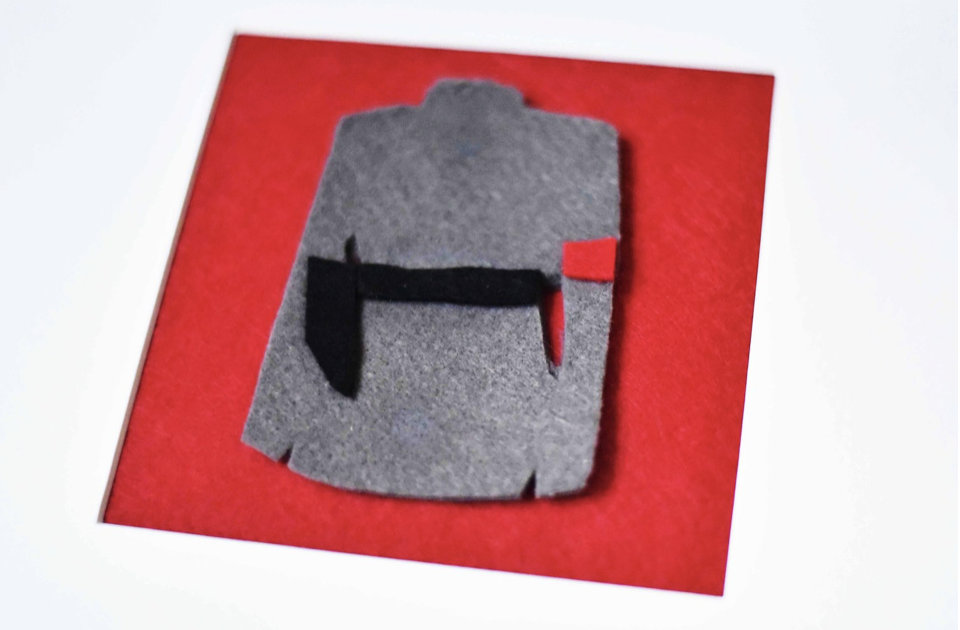
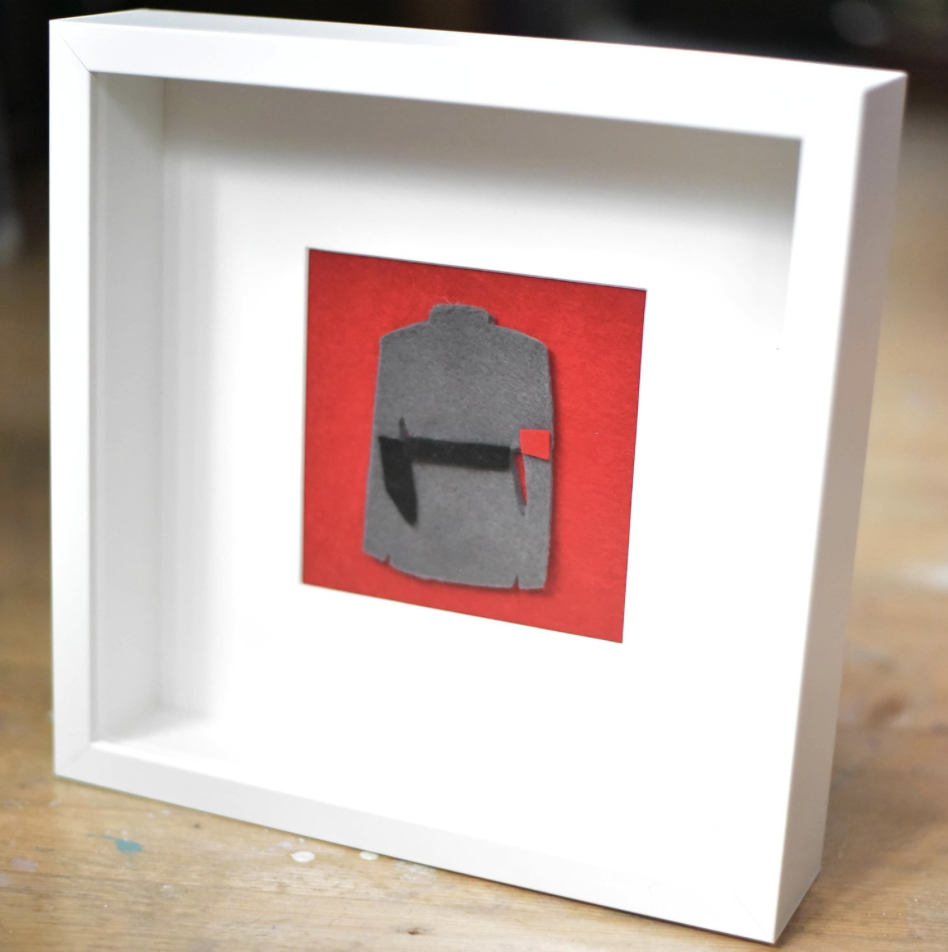
Ava Weis “Wer hat gesagt, dass Beuys ein Nazi war?” (Filz auf Filz auf Filz)
In 2013 author Hans Peter Riegel published the first volume of his revolutionary Beuys biography. So far, four volumes shed a light on Joseph Beuys‘ (lies about his) childhood and teenage years, family, career, as well as his role in Nazi Germany. Throughout his lifetime, Beuys changed the narrative about his birthplace, his father’s name, his childhood memories, his curriculum, his success in school and during his studies, and his military training as well as accomplishments. While Beuys pretended that his hometown Kleve was an “enclave of decent people” and “far from national socialist reality” during the Nazi period, the photographer Otto Weber captured several Nazi events, rallies and gatherings which therefore prove that Beuys hometown did not differ from other german towns at all. According to Riegel, Beuys probably even attended the inauguration of the cities‘ war monument in 1943 and eventually also witnessed antisemitic attacks in Kleve.
Later in life, he repeatedly downplayed the antisemitism of his jewish classmates. In September 1936, Beuys attended the so-called Sternmarsch of the Hitler Youth, a demonstration march, in honor of the 8th political convention of the German Nazi party. When asked about the Hitler Youth decades later, he emphasized that not in the least was manipulation a factor regarding the way he and other young people were treated in this organization. His biography, published in 1973, even brings up a legend about a young Beuys saving books – in broad daylight, in front of numerous members of the Hitler Youth – during a burning of indexed books in his school in 1933.
Beuys even romanticized this time creating a legend about how he periodically joined a touring circus for 1 to 2 years. Not only were circuses guarded and frowned upon during the Nazi period, and it would have been impossible for a teen to simply join them for a few months or even years, actually also Beuys former class mates didn’t confirm his month-long absence from school.
In 1940 Beuys, an underachiever who never finished school and nonetheless later on was described as an intellectual by several historians, made the decision to join the military. In 1980 Beuys was interviewed for Penthouse Magazine, where he described his wartime deployment as “morally right” and “equitable decision” and a symbol for his “solidarity with his coevals”. Furthermore, according to Beuys, not joining the military would have meant to have a “gutless pacifistic attitude”.
He saw his military time for Nazi Germany as an “educational experience”. “War meant life for me”, he told his interviewer. Beuys, who has always claimed that he worked as a pilot for the German military, was actually only trained to become a radio operator due to a red-green deficiency. “Killing without hesitation” was the aim of every soldier’s training. This aim applied to Beuys, too. In 1980 he vaguely claimed that there probably have been fatalities, but that he never had feelings of guilt. Although killing civilians was part of a soldier’s everyday life, Beuys always denied doing so.
The so-called Tartar Legend was created by Beuys after surviving a plane crash in march 1944. While Beuys claimed in 1973 that he maneuvered the plane through a snowstorm, it is documented that there was no snow in the Crimea until the end of march and also Beuys wasn’t the pilot of the plane but Hans Laurinck. Beuys also described severe injuries such as a fractured skull, although only minor injuries had been documented by medical staff. Since the early 1970s Beuys repeatedly told a story about how he was saved by nomadic Tartars after two weeks in the enemies‘ territory while being heavily injured, unconscious and covered by snow when German soldiers had already given up searching for him. Riegel describes this legend as a fairy tale that was created by Beuys and later on used by historians to interpret Beuys works. Beuys himself used this legend to emphasize how his works made from felt and fat were inspired by the Tartars‘ felt tents and the fat they used to embalm his body. Beuys also described having been able to create a close and family-like relationship with the Tartars.
According to Riegel, this is another lie regarding the fact that in 1943 there was only one living Tartar left and the area near Karankut was depopulated since the 1930s due to a mobility ban for civilians which meant that everyone who was caught flouting the law risked a death sentence. Based on the Tartar Legend, Beuys and his followers created the image of Beuys, the Man of Sorrows and the shaman. Riegel furthermore refers to another lie told by Beuys since 1974, when Beuys claimed that he began to study biology, physics, and mathematics when he was released from captivity in 1945 – without having a proper qualification – before he then made the decision to apply for the Düsseldorfer Kunstakademie in 1946 to which he was admitted pretending that he graduated from school in 1941. The beginning of his artist career is therefore based on a deliberate deception.
written by Lisa Jureczko
Sources
Catrin Lorch, Die wirren rechten Ideen des Joseph Beuys, in: Süddeutsche Zeitung, 2018
Christiane Hoffmans, „Das ist völkische Diktion in Reinkultur“, in: WELT, 2013
Christiane Hoffmans, Das rechte, völkische Gedankengut des Joseph Beuys, in: WELT, 2018
Hans-Joachim Müller, Joseph Beuys, ein Fachverkäufer der hohlen Kunst, in: WELT, 2017
Hans Peter Riegel, Beuys: Die Biographie (Band 1 bis 4), 2021
Hans Peter Riegel, Interview: „Ich verdanke Beuys den unabdingbaren Willen, etwas zu bewirken.“, in: SWR2, 2021
Hans Peter Riegel, Interview: „Man muss Beuys den Heiligenschein nehmen.“, in: die presse, 2021
Hans Peter Riegel, Interview: „Beuys war bis ins Mark völkisch.“, in: Frankfurther Rundschau, 2013
Thomas Kerstan, Lernen für den Führer, Ein Gespräch mit der Historikerin Anne C. Nagel, in: DIE ZEIT Nr.45/2012
lisa jureczko & avan weis – curators of re:visionism & hysteria
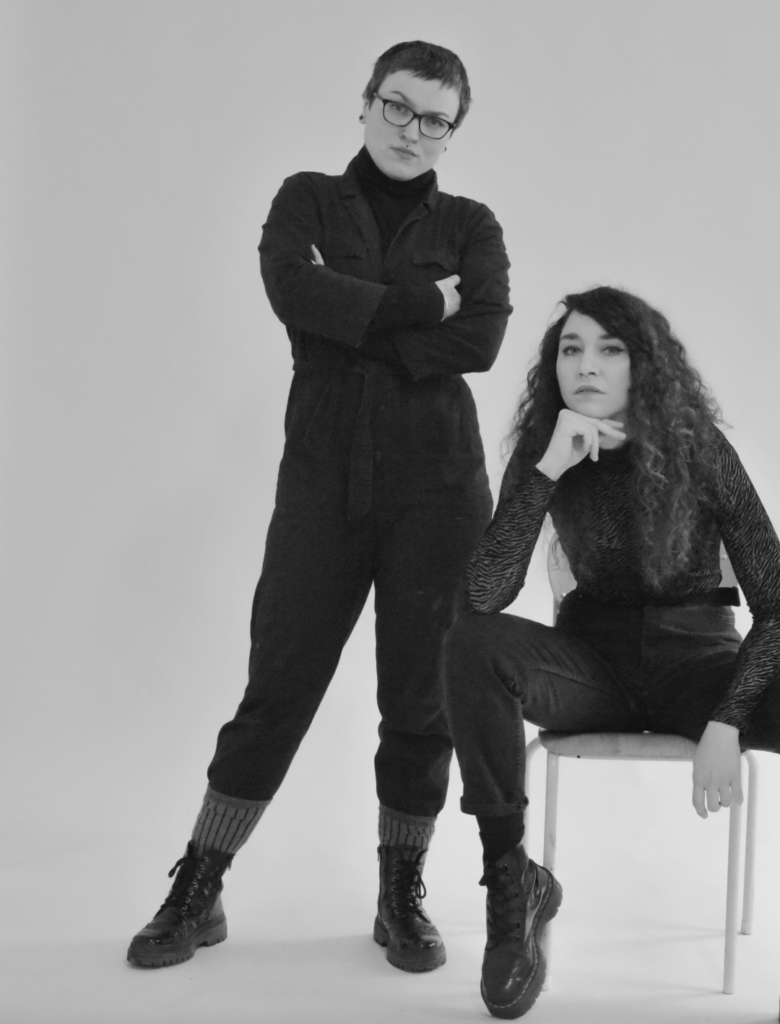
Lisa Jureczko is a freelance photographer, artist, author and curator. In her work she sheds light on the fashion industrie‘s impact on humans as well as on our environment, but also on social justice issues in general, especially regarding the consequences and facets of psychological violence. Furthermore, she aims to destigmatize certain topics with an interdisciplinary and intersectional approach.
Lisa Jureczko was born and raised in Düsseldorf and studied Art History, Italian and Archaeology in Rome and Cologne. Her scientific publications focus on portrait science and the cultural reception of antiquity. In 2014 she began to work as a freelance fashion and beauty photographer, which resulted in numerous international publications and exhibitions.
Her current work is characterized by the motivation to combine art, activism and science.
Avan Amir Weis is a German-Irish artist who collages photography, poetry and a splash of ink and paint to analyze gender, sexuality, mental health and desire. They often use their own body to get rid of the ‚male gaze‘ and establish a new view on what we describe as our ’self‘. Born in Hamburg they moved to Wuppertal to go to school and spend most of their childhood on a ship between Germany and Ireland. They studied Philosophy, Islam Studies, Theology at Ruhr-Universität Bochum and African Studies, Philosophy and Dutch Studies at Universität zu Köln with a focus on Art and Gender. For several years now they work as a (feminist) journalist, photographer and lecturer for youth projects always searching for their artistic voice.
Kritische Kuration: ein interaktiver workshop mit larissa-diana fuhrmann
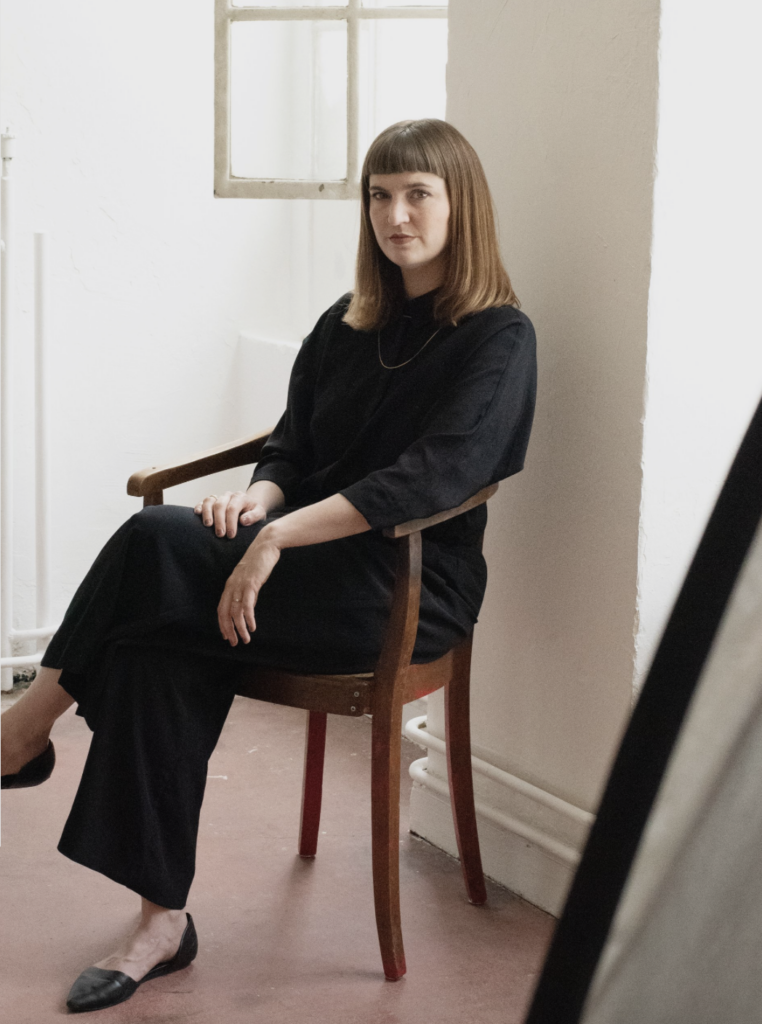
Larissa-Diana Fuhrmann arbeitet als Kuratorin und Wissenschaftlerin an der Schnittstelle zwischen Kunst und Aktivismus. Dabei stehen eine kritische Praxis und kollaboratives Arbeiten im Zentrum ihrer Auseinandersetzungen. In ihrem letzten Projekt hat sie sich als Ko-Kuratorin der Ausstellung “Mindbombs” an der Kunsthalle Mannheim mit den Auswirkungen politischer Gewalt auf visuelle Kulturen auseinandergesetzt und reflektiert diese Erfahrung in ihrem Dissertationsprojekt “The Art of Contesting Political Violence”.
Das Wort #kuratieren kommt vom lateinischen “curare”, was so viel wie “pflegen” und “für etwas sorgen” bedeutet. Aber was wird gepflegt und um was wird sich gesorgt in der aktuellen Praxis von Kurator:innen in Deutschland?
Welche Strategien und Handlungsformen können uns zu einer kritischen und bewussten Kurationspraxis führen? Welche Ansätze existieren im Bezug auf antirassistische, feministische, institutionskritische und kollektive Praxen?
Wie können marginalisierte Positionen nachhaltig gestärkt und institutionelle Machtstrukturen unterminiert werden?
Mit diesen und weiteren Fragen beschäftigten sich die Teilnehmer:innen und die Workshop-Leitung während des interaktiven Workshop “Kritische Kuration”, der am 23.01.2022 von 12 bis 14 Uhr via Zoom stattgefunden hat.
Teilgenommen haben sowohl Menschen, die sich für das Thema Kuration interessieren, als auch Personen, die bereits Erfahrungen als Kurator:in gesammelt haben.